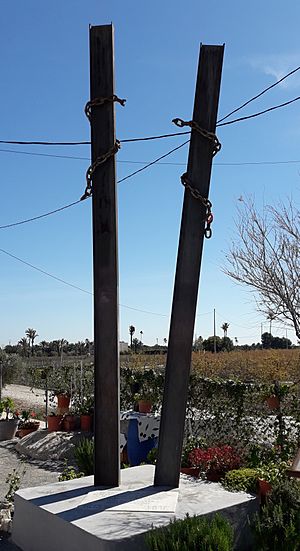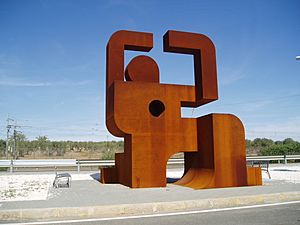Francoist concentration camps facts for kids
During the time of Francoist Spain, many special camps were used to hold people. From 1936 to 1947, at least 200 to 300 of these camps were set up. Some were permanent, while others were only used for a short time. This network of camps was a key part of how the Franco government controlled and punished people.
Many different groups of people ended up in these camps. This included soldiers from the People's Army, the Air Force, and the Navy. Also, political opponents and their families, poor people, Moroccan separatists, homosexuals, gypsies, and regular prisoners were held there.
Special groups called "Classified Commissions" decided what would happen to the people in the camps. Some were called "recoverable" and were set free. Others, seen as "minority disaffected" (meaning they didn't fully support the government but weren't major political threats), were sent to work in special battalions. Those considered "seriously disaffected" were sent to prison and faced military trials. People called "common criminals" were also sent to prison.
Official records show that after the Civil War, about 177,905 enemy soldiers were held in around 100 camps. They waited there to be classified. The records also state that a total of 431,251 people passed through these camps.
Like in many other Concentration Camps, prisoners were sometimes ranked. Regular prisoners, who had committed non-political crimes, were sometimes given a higher status. They even acted as "guards" (called cabos de vara) over other prisoners. Even though many records about the camps were destroyed, studies show that prisoners were often forced to work in special worker battalions.
Historians agree that the conditions in these camps were generally terrible. This is based on stories from survivors, witnesses, and even Franco's own reports. The rebels did not see Republican soldiers as prisoners of war. This meant that the Geneva Convention of 1929, which Spain had signed, did not apply to them.
Because of this, prisoners were often treated unfairly. They were forced to do military work, which the Convention banned. Many were held without being charged with a crime. They faced harsh treatment to get information or confessions. There were also no proper legal protections for them. On top of this, there was a lot of corruption in how the camps were run. Many military officers became rich, which made the prisoners' suffering even worse.
History
According to Javier Rodrigo, about half a million prisoners were held in these concentration camps between 1936 and 1942. In 2019, Carlos Hernández de Miguel found about 300 confirmed camps. He believes that between 700,000 and 1 million people passed through them.
The first concentration camp was opened by the rebel military on July 19, 1936. This was just hours after the uprising began, near Melilla. The next day, a newspaper called the Rif Telegram reported that the camp was open. It was located in the Alcazaba of Zeluán, an old fortress.
Francisco Franco was told about this right away. He was happy with the idea and ordered more camps to be opened. He wanted to hold "disturbing elements" and make them work on public projects. On July 20, Franco told Coronel Eduardo Sáenz de Buruaga, who was in charge of Tetuán: "I've heard there are hundreds of detainees, and prisons can't hold them all. To avoid our new punishments becoming a public sight for foreign reporters, we need a solution. Concentration camps on the outskirts could work. In Melilla, they've already opened one in Zeluán with good results."
This led to the creation of the El Mogote concentration camp. It was placed in a spot where the harsh conditions could be hidden from outsiders. On August 20, 52 prisoners were killed there, and Franco knew about it.
The next place where rebels set up camps was the Canary Islands. One camp was on the military grounds of La Isleta peninsula in Gran Canaria. It operated until the end of July 1936. Many prisoners from the Canarian camps died or disappeared. Like in North Africa, the nationalist newspapers hid the truth about the camps. They showed a peaceful picture that was far from reality. Other places, like the military prison in Mount Hacho de Ceuta Castle, were also used as camps, even if they weren't officially called that.
Some historians believe that Nazi officials from the Gestapo helped organize Franco's concentration camp system. They think the Spanish camps were largely inspired by Nazi Germany's own camps. One important Nazi officer was Paul Winzer, who was the head of the Gestapo in Spain. He was also in charge of the Miranda de Ebro concentration camp for a while. Some authors even say Winzer was the main person behind the entire Francoist camp system. Other facilities, like those in Laredo, Castro Urdiales, Santander, and El Dueso, were first managed by soldiers from Fascist Italy.
On July 5, 1937, the General Inspectorate of the Concentration Camps of Prisoners (ICCP) was created. Coronel Luis Martín Pinillos was put in charge. Its goal was to manage all the camps from one central place. However, it often had problems with military leaders in other parts of the country, especially General Queipo de Llano in the South. The camps in Andalusia operated outside the ICCP until mid-1938. Camps in the Balearic Islands, the Canary Islands, and the Protectorate of Morocco kept almost complete control until the war ended.
In 1938, Franco's concentration camps held over 170,000 prisoners. After the war ended in 1939, the number of prisoners in camps and prisons ranged from 367,000 to 500,000. From 1940, General Camilo Alonso Vega oversaw all these camps. The main purpose of the camps was to hold as many Republican prisoners of war as possible. Those considered "unrecoverable" were often executed.
Many people in charge of the camps had suffered losses in the Republican zone. Because of this, they often showed anger and a desire for revenge against the defeated. High-ranking officials also supported this harsh environment. The Director-General of Prisoners, Máximo Cuervo Radigales, and the head of the Military Legal Corps, Lorenzo Martínez Fuset, greatly contributed to this harsh treatment.
By 1946, ten years after the Civil War started, 137 labor camps and 3 concentration camps were still open. They held 30,000 political prisoners. The last concentration camp to close was Miranda de Ebro, which shut down in January 1947.
The treatment of inmates

Harsh treatment and abuse were common in the concentration camps. Many inmates had not been formally charged with any crime. They lived in terrible conditions with little food, disease, and overcrowding. Corruption was also a big problem. Often, the people who beat prisoners were Falangists (supporters of Franco's party) or relatives of victims. These people were allowed into the camps.
Prisoners faced brutal punishments from their guards. Many guards were former soldiers, ex-prisoners, or relatives of people who suffered during the Republican period. The cabos de vara also played a role in this. Prisoners called "disaffected" were forced to do hard labor in special work groups.
Spanish exiles and brigades in Nazi camps
Many Spanish Republicans went into exile in France. It is believed that around 10,000 of them ended up in Nazi concentration camps. Franco's foreign minister, Ramón Serrano Súñer, did nothing to help them. There are documents showing that the Germans asked what to do with "two thousand Spanish reds of Angouleme." The few who survived could not return to Spain.
Franco's government also worked with their Nazi allies. They handed over Czech, Belgian, or German prisoners. These prisoners were sent to prisons and concentration camps of the Third Reich, where many of them died. Franco personally ordered these transfers, even when his own officials disagreed. Minister Gómez-Jordana wrote on a diplomatic report: "His Excellency, General-in-Chief ordered them to surrender."
In the San Pedro camp, international brigade members were sometimes exchanged for prisoners held by the Republican government. A small number of these exchanges happened. This allowed some soldiers from Nazi Germany and Fascist Italy to return to their home countries.
See also
 In Spanish: Campos de concentración franquistas para niños
In Spanish: Campos de concentración franquistas para niños
- Francoist repression


